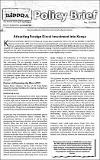| dc.date.accessioned | 2021-05-06T09:36:45Z | |
| dc.date.available | 2021-05-06T09:36:45Z | |
| dc.date.issued | 2006 | |
| dc.identifier.uri | http://repository.kippra.or.ke/handle/123456789/2919 | |
| dc.description | This policy brief is based on KIPPRA Discussion Paper
No. 48 of 2005 on Institutional Factors and Foreign
Direct Investment Flows: Implications for Kenya. The
study analyses various factors that influence foreign
direct investment, using and empirical analysis that
brings together traditional and non-traditional
factors. | en |
| dc.description.abstract | Kenya has witnessed a decline in net flows of foreign direct investment (FDI) in the last two decades. A significant
decline occured in the 1990s when the economy was going through various policy and institutional changes,coupled
with un-sustained improvement in macroeconomic environment.While the early 2000s indicate a rise in inflows, this is
coupled with huge outflows, meaning that the economy is losing in its ability to sustain FOi.The country shared 87% of FOi in
East Africa in the 1980s.This declined to 21 % in 2001 and 5.3% in 2002.Kenyan firms are increasingly re-locating to Uganda
and Tanzania, implying that Kenya is losing its competitiveness to the neighbouring countries. | en |
| dc.language.iso | en | en |
| dc.publisher | The Kenya Institute for Public Policy Research and Analysis | en |
| dc.relation.ispartofseries | Policy brief No.15 of 2006; | |
| dc.subject | Foreign Direct Investment | en |
| dc.subject | Infrastructure development | en |
| dc.subject | Political risk factor | en |
| dc.subject | Macroeconomic issues | en |
| dc.title | Policy Brief No. 15 of 2006 on Attractig Foreign Direct Investment into Kenya | en |
| dc.type | KIPPRA Publications | en |
| ppr.contributor.author | The Kenya Institute for Public Policy Research and Analysis | en |

